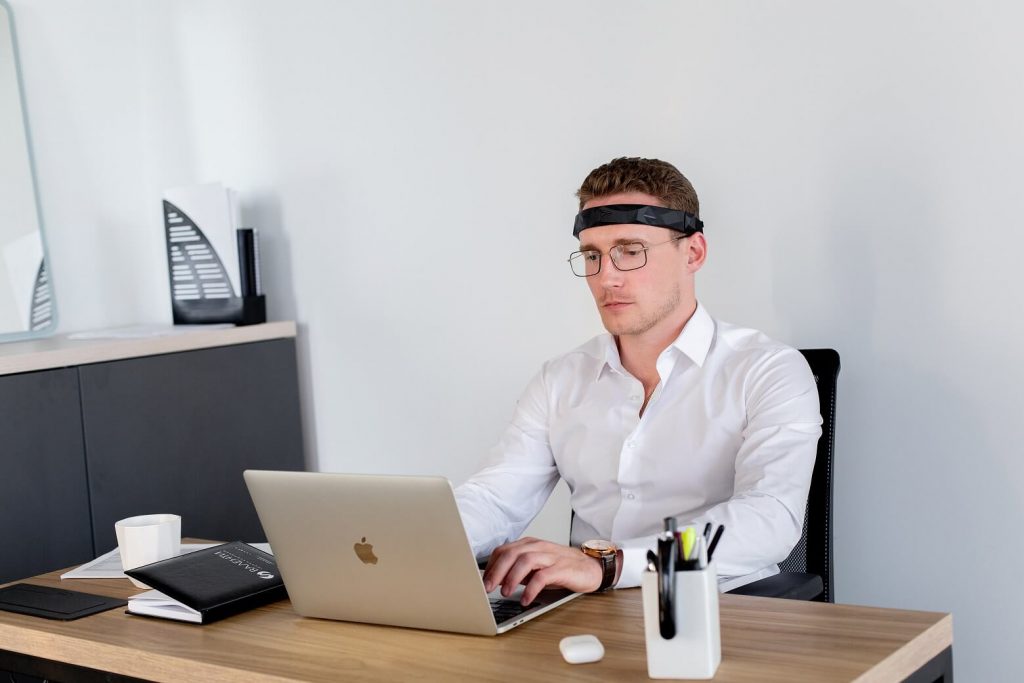Neurodoctor
Medicine is one of the key applications of neurotechnology, and the first thing we see is
There are several other startups with similar features.a chip with electrodes that, when implanted, pass through vessels into the brain, and has attracted $75 million in investment, including fromBill Gates and Jeff Bezos.Peter took part in another projectThiel, known as one of the founders of the PayPal system, invested $ 10 million in Blackrock Neurotech, which released an implant that has already proven itself and proven over the years.It is about the size of a small coin and is attached to the motor cortex of the brain.A patient with a speech disorder participated in the experiment on its use.It made inarticulate sounds that no microphone, neither Siri nor Google, could understand.In her case, the activity was taken directly from the brain, and the neural interface translated all this into printed text.
Brain Fitness
The second trend grows out of the modern rhythmlife, which forces us to take on more risks and responsibilities and be in constant stress. This creates a need for brain trackers that help you relax, know yourself and monitor your psycho-emotional state. Everyone already has a smartwatch that tracks activity levels, heart rate, blood pressure and other metrics, but no one has a device to monitor brain fatigue levels. The Neiry company has launched a mind tracker on the market that allows you to pump up your stress tolerance.
 Mind tracker
Mind tracker
A mind tracker is like a fitness bracelet, only forbrain. A headband or headphones with soft movable gold-plated electrodes fit snugly against the scalp and take an encephalogram, and a special application, based on the data obtained, determines what state the user is in: whether he feels relaxed, involved, tired, excited or stressed. If a person's well-being is determined by the program as uncomfortable, she recommends undergoing special training to combat stress. As part of such an activity, the user listens to sounds: the better the person relaxes, the clearer the signal. There is also such an option as maintaining attention at the level necessary for solving complex problems.
Neurostimulation methods also allow you to fight andwith disorders such as anxiety and depression. Drug treatment is not effective for everyone, psychotherapy is not available to everyone. In this direction, in particular, the startup Inner Cosmos is successfully working and attracting investments. The volunteer was implanted in the head with an implant with electrodes that once a day send impulses to a specific part of the brain. If the study yields good results within a year, the method could be used to treat resistant depression.
The power of thought
The third trend that has attracted the attention of investors isconverting brain signals into one activity or another. Take, for example, Zuckerberg's bracelet from CTRL-Labs. It can already read motor neuron activity from the wrist muscles. In the future, purely technically, this will make it possible to activate the buttons on the keyboard faster than pressing a finger, because the physical movement of all muscles and bones is replaced by neuroactivity. And although each click saves only about 100 ms, there are a lot of them, so in general typing is much faster, the developers assure.
This group also includes “reading”brain reactions to a predetermined stimulus. There is, for example, a technology called P300. This is a signal that is triggered 300 ms after a person sees something familiar. This project is good for airports and baggage checking services. The point is that a person, a professional in this field, receives airport network data on the screen at a fairly high speed, 8–10 frames per second. And when his trained brain notices something suspicious, the P300 potential is triggered - and the marked picture is sent to airport security.
Commercial break
The fourth trend is the use of neurotechnologies infield of marketing and advertising. It’s safe to say that many films, including Russian ones, have gone through neuromarketing research. A person is shown a film or commercial, or uses an application or website. During viewing, the activity of his brain is recorded: the subject likes what he saw or does not like how much he strives to receive the advertised product, or, on the contrary, he wants to avoid what is shown to him. At the same time, an eye tracker is used to track which screen area he looks at most often: this is especially important for websites. Based on the data obtained, decisions are made on what to leave in the film and what to remove from it, it is revealed what people do not respond to and what irritates them.
Self Improved Gaming
Neurointerfaces are no less actively implemented inthe field of entertainment. State detection can be used very well in the context of gaming. So, Valve, which owns the Steam game store, uses special equipment during testing in order to understand what is good and what is not very good in the game. And this is also, on the one hand, neuromarketing, and on the other hand, it is a way to create games adapted in complexity in the future. For example, if the neural device detects that the player is bored, they throw another wave of zombies at him. And by the way, thanks to the development of neurocontrol technologies in the future, games can become much faster and more interesting.
Read more:
Physicists have found a way to overcome the limitation on the size of semiconductors
Treasure found that was hidden during the war almost 1,000 years ago
The secret of longevity is revealed: scientists have figured out how to start the necessary mechanism in the human body